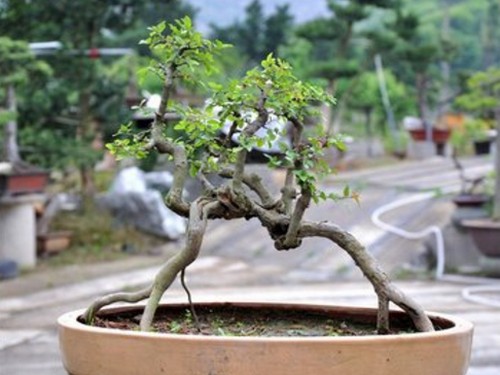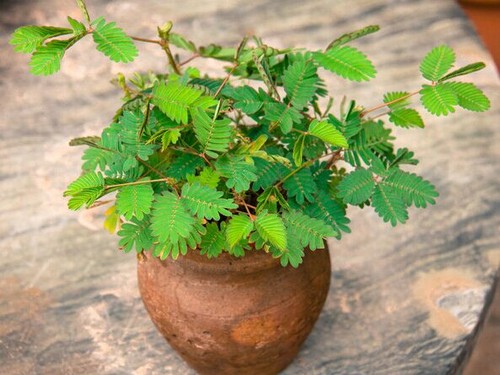Maintenance knowledge of sparrow plum bonsai
Sparrow plum, commonly known as rat rice, sour taste, rodent rice family sparrow plum vine plant, originated in China's southeast coastal provinces and regions, Japan, India also have. Sparrow plum is a spiny deciduous shrub with nearly opposite leaves, thinly leathery, evergreen or semi-evergreen, ovate or oval, margin serrulate; florescence from September to October, light yellow, fragrant, arranged into panicles of spike branches; fruit globose, ripening period for the following April to May, purple-black, slightly sour and refreshing, so it is also called "sour taste".

Finch plum bonsai is easy to be affected by external climate and attacked by diseases and insect pests because of its lack of soil and thin soil. Therefore, it is necessary to do a good job in pruning, fertilization, watering, changing pots, cold prevention and pest control, and control growth in order to maintain the graceful posture of the tree.
Avoid the light: sparrow plum bonsai has little soil and shallow roots, and the scorching sun can easily make buds, shoots and leaves get sunburned or die. Therefore, it is necessary to shade the sun in summer, build a shade shed or put it indoors, under the eaves, in the shade of trees and other places where there is no direct sunlight.
Temperature: Finch plum bonsai has poor cold resistance, easy to freeze and dry up, and even die. Therefore, the winter should be kept indoors, and pay attention to ventilation, the room temperature should be kept above 5 ℃; when the room temperature exceeds 25 ℃, the window can be opened to avoid excessive growth caused by high temperature; when the room temperature is less than 5 ℃, the plastic insulation can be covered (the greenhouse is higher than 5 ℃, that is, remove the plastic bag) when the room temperature is less than 0 ℃, the heating method such as hot water should be used to ensure the Finch plum bonsai to survive the winter safely.
Soil: potted soil should be good Finch plum stumps originally grow in wild areas, with well-developed roots, drought and waterlogging resistance. Once they are dug up and planted in a shallow basin close by, the growth conditions are limited, such as improper maintenance and easy death, so they should be taken care of very carefully. To choose a well-drained flower paste, during maintenance, the basin soil had better be thicker. Change the new soil every two years and apply some base fertilizer to protect the fertile soil in order to make the pile scene grow normally.
Watering: it is better to use natural water such as river water, pond water, Rain Water and so on. If tap water needs to be stored for a day or two, it is more appropriate to make the chlorine run away and reuse. Laundry water containing soap, and water with oil and salt should never be used. Watering should be careful not to make the basin soil too wet or dry. Water once in the morning and once in the evening in the summer. In order to shorten the branches and leaves and make the shape more beautiful, the water can be properly controlled in spring and summer.
Fertilization: fertilization should pay attention to excessive fertilizer application, branches and leaves grow, lack of fertilizer, the branches are thin and weak, the leaves turn yellow, and they are vulnerable to diseases and insect pests. Therefore, fertilization should have principles: newly planted, first pot, just changed pot, root damage within a month can not be fertilized. In spring and summer, when potted trees grow in peak season, more fertilizer must be applied. After autumn, potted trees should be applied less if they grow slowly. In winter, potted trees can stop fertilizing when they go dormant. It is not suitable to apply fertilizer around noon in rainy days or midsummer. The application of fertilizer solution is best in cloudy days or in the evening, when the basin soil is slightly dry, it is necessary to loosen the soil to facilitate the infiltration of fertilizer and water into the soil. In order to speed up the decomposition of fertilizer, it must be drenched the next morning. Finch plum bonsai can be used cake fertilizer, kitchen waste in the tank sealed fermentation, take the upper layer of fertilizer and water 4 times diluted 5 times. Sparrow plum is an acid-loving plant, which should be applied only by adding 1% ferrous sulfate to the retting fertilizer and water; spraying 0.1% urea twice during germination; spraying 0.1% 0.2% potassium dihydrogen phosphate before and after flowering.
Pruning: pruning should be timely and general pruning time, which is suitable in late spring and early autumn, when the sprouting power of sparrow plum stump is the strongest and the growth is the most prosperous. Cut off long branches, overlapping branches, cross branches, radiant branches, withered branches, diseases and insect pests at any time. However, it should be noted that in hot weather, it is easy to burn new buds, so as to roll leaves, therefore, after pruning, it is best to put it in a cool place to see strong light after sprouting normally. The sparrow plum stump bonsai can be pruned all the year round to cut off the overgrown and over-dense branches that hinder the shape at any time, so that the stump can maintain a beautiful shape, proper density of branches and leaves, ventilation and light, and reduce the occurrence of diseases and insect pests.
Turn the basin: Finch plum bonsai should be turned once every 4 years before sprouting in spring. When turning the basin, cut off some of the old roots, withered roots and overgrown and dense roots, replace the old soil of 1max 2, and cultivate fertile and loose culture soil to promote the growth and development of new roots.
Diseases and insect pests: to control sparrow plum stump diseases and insect pests are common longicorn beetles, commonly known as "heart bugs". The female longicorn beetle bites through the bark to lay eggs on the branches, and the newly hatched larvae eat under the bark and grow into the trunk and roots. the damaged plants are often eaten and withered. During the prevention and control, the position of the insect pest can be judged according to the feces, and the larvae can be stabbed with appropriate iron wire, or the cotton ball plug wormhole can be soaked with 200 times solution of dichlorvos, the larvae can be poisoned with medicine, and then sealed with wet mud.
Red spider, also known as fire spider, is also a common pest of Finch plum pile scene, its body is less than 1 mm, orange-red or reddish brown oval. The red spider forms a web on the plant leaves and uses its mouthparts to pierce into the branches and leaves to absorb juice, the chlorophyll of the damaged leaves is destroyed, the color becomes yellow and pale, the leaves show fine gray-yellow spots, the leaves gradually wither and fall, and some even the whole plant leaves are stripped and withered. Can spray dichlorvos or dimethoate 1000 times liquid to 1500 times liquid, eliminate it.
Note:
Sparrow plum bonsai pay attention to maintenance in winter, can keep the leaves do not fall off, evergreen, its roots flat knot, branches horizontal oblique, leaves small color green, the shape is very ancient and elegant. And the newly planted sparrow plum bonsai, due to pruning and other factors, the roots are damaged to a certain extent, do not apply fertilizer within 20 days. Finch plum enters a prosperous growth period after the end of spring, applying rotten and thin liquid fertilizer every half a month or so. Fertilization should generally be in the case of relatively dry basin soil, combined with the principle of watering at the same time, fertilizing before water, so that fertilizer can quickly seep to the lower part of the basin, which is conducive to root absorption. Sparrow plum enters the dormant period in winter, do not apply fertilizer. Finch plum bonsai fertilization method first ends here, I hope it can help everyone.
Time: 2019-06-01 Click:
- Prev

How to raise potted plum blossoms
Prunus mume blossom is a traditional and valuable ornamental flower and tree which is a specialty of our country. It has a long cultivation history and rich Lamei culture. That we are familiar with the song "Divination operator Yong Mei" praised: several plums in the corner, braving the cold alone proudly in full bloom; from a distance, we already know that it is not snow, only dark fragrance. Praised the preserved plum for not being afraid of the cold and opening in the cold.
- Next

How about mimosa? how to maintain mimosa?
Mimosa is a wonderful plant that can predict changes in the weather. If you touch it with your hand, its leaves close quickly and open slowly, indicating that the weather will clear up; if you touch mimosa, its leaves contract slowly, sag slowly, or even reopen after a little closure.
Related
- Fuxing push coffee new agricultural production and marketing class: lack of small-scale processing plants
- Jujube rice field leisure farm deep ploughing Yilan for five years to create a space for organic food and play
- Nongyu Farm-A trial of organic papaya for brave women with advanced technology
- Four points for attention in the prevention and control of diseases and insect pests of edible fungi
- How to add nutrient solution to Edible Fungi
- Is there any good way to control edible fungus mites?
- Open Inoculation Technology of Edible Fungi
- Is there any clever way to use fertilizer for edible fungus in winter?
- What agents are used to kill the pathogens of edible fungi in the mushroom shed?
- Rapid drying of Edible Fungi

